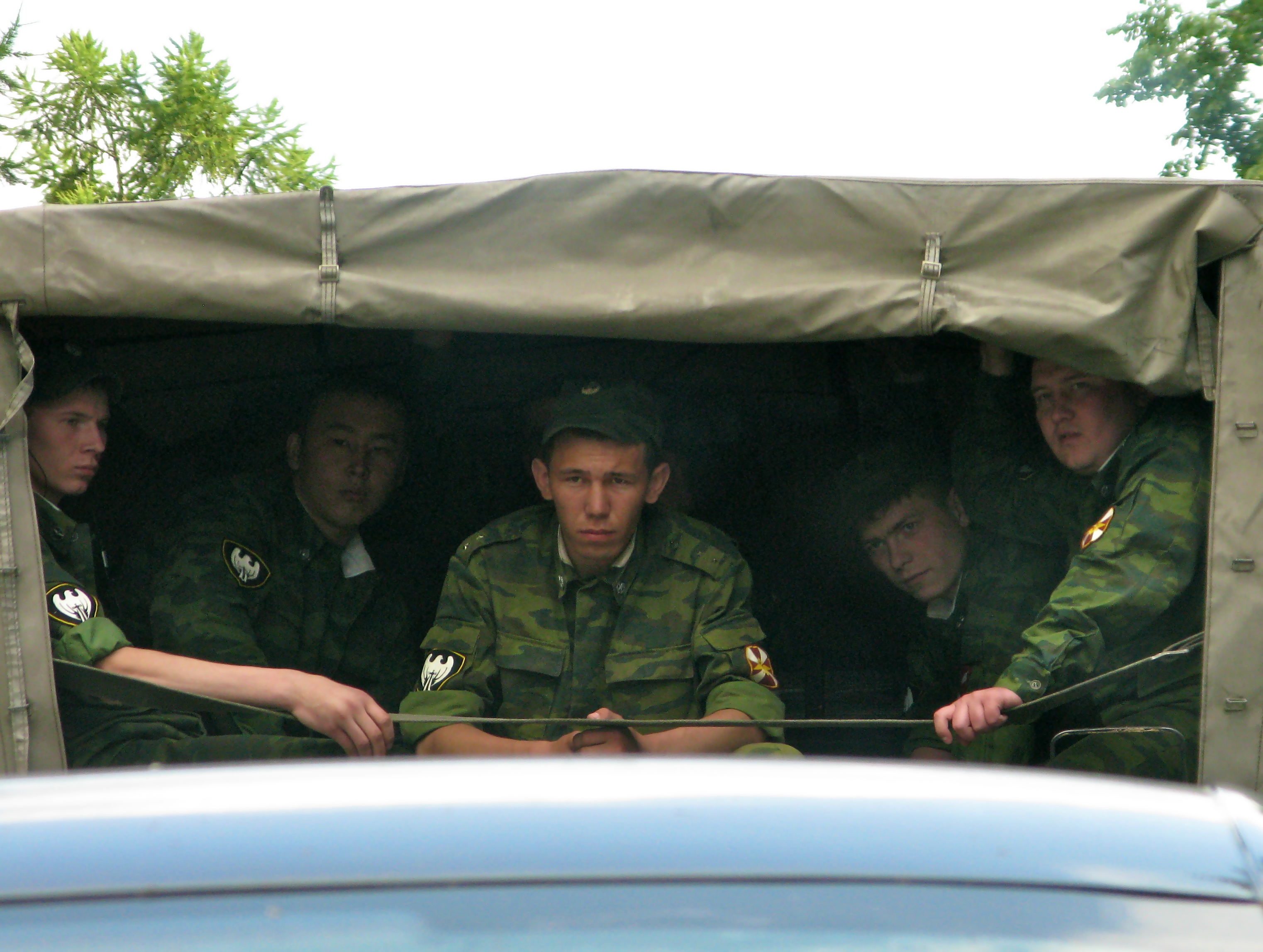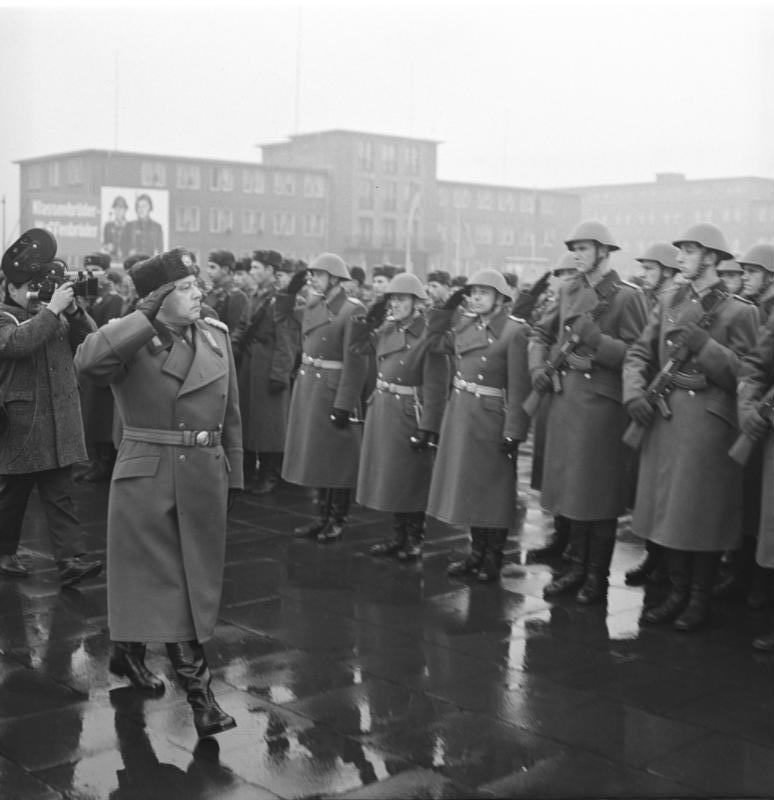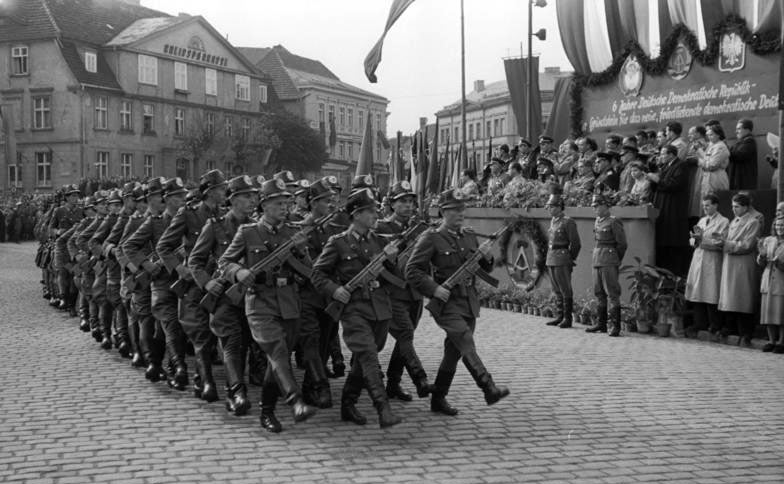|
Volkspolizei-Bereitschaft
The ''Volkspolizei-Bereitschaften'' (VPB, German for "People's Police Alert Units") were paramilitary police units of the German Democratic Republic (East Germany) from 1955 to 1990. The VPB were barracked units of the ''Volkspolizei'' for riot control and counterinsurgency with regiment status, under control of the Ministry of the Interior and considered part of the armed forces, but were never part of the National People's Army or the Ministry of National Defence. The VPB were organized as Internal Troops like in many Warsaw Pact countries. The VPB functioned as the ''de facto'' armed branch of the Ministry for State Security (Stasi), the secret police force of the German Democratic Republic, although this ministry had its own military unit, the "Felix Dzerzhinsky Guards Regiment" as well. Organization The German Democratic Republic's Ministry of the Interior (German: ''Ministerium des Innern'', or MdI) maintained the independent Department of the Alert Units of the ''V ... [...More Info...] [...Related Items...] OR: [Wikipedia] [Google] [Baidu] |
East Germany
East Germany, officially the German Democratic Republic (GDR; german: Deutsche Demokratische Republik, , DDR, ), was a country that existed from its creation on 7 October 1949 until its dissolution on 3 October 1990. In these years the state was a part of the Eastern Bloc in the Cold War. Commonly described as a communist state, it described itself as a socialist "workers' and peasants' state".Patrick Major, Jonathan Osmond, ''The Workers' and Peasants' State: Communism and Society in East Germany Under Ulbricht 1945–71'', Manchester University Press, 2002, Its territory was administered and occupied by Soviet forces following the end of World War II—the Soviet occupation zone of the Potsdam Agreement, bounded on the east by the Oder–Neisse line. The Soviet zone surrounded West Berlin but did not include it and West Berlin remained outside the jurisdiction of the GDR. Most scholars and academics describe the GDR as a totalitarian dictatorship. The GDR was establish ... [...More Info...] [...Related Items...] OR: [Wikipedia] [Google] [Baidu] |
Internal Troops
The Internal Troops, full name Internal Troops of the Ministry for Internal Affairs (MVD) (russian: Внутренние войска Министерства внутренних дел, Vnutrenniye Voiska Ministerstva Vnutrennikh Del; abbreviated ''ВВ'', ''VV''), alternatively translated as "Interior (Troops or Forces)", is a paramilitary gendarmerie-like force mostly in successor states of the Soviet Union and in other countries as well, including in Russia (until 2016), Ukraine (until 2014), Georgia (until 2004), Kazakhstan (until 2014), Kyrgyzstan, Azerbaijan, Belarus, Turkmenistan, and Tajikistan. It is also maintained as reserve forces in the Armed Forces of Mongolia. Internal Troops are subordinated to the interior ministries of the respective countries. They were designed to be used to support and reinforce the ''Militsiya'' (police forces), deal with large-scale crowd control, internal armed conflicts, prison security (except in Russia) and safeguarding of highly ... [...More Info...] [...Related Items...] OR: [Wikipedia] [Google] [Baidu] |
Felix Dzerzhinsky Guards Regiment
The Felix Dzerzhinsky Guards Regiment (German: ''Wachregiment "Feliks E. Dzierzynski"'') was the paramilitary wing of the Ministry for State Security (''Stasi''), the security service of the German Democratic Republic (GDR). The Felix Dzerzhinsky Guards Regiment was called a regiment, however the elite formation gradually grew to the size of a motorized infantry division with its constituent ''Kommandos'' made up of battalions. Its role in the Stasi was the protection of buildings and high-ranking officials of the GDR government and the Socialist Unity Party of Germany. It was composed of experienced and ideologically reliable men separate from the National People's Army that could be deployed to suppress rebellion and unrest.Forester, Thomas M., The East German Army; Second in the Warsaw Pact, George Allen & Unwin Ltd, London, 1980. History The Guards Battalion A at the MfS (''Wachbataillon A beim MfS'') was founded on January 1, 1951 as an armed force to complement the Min ... [...More Info...] [...Related Items...] OR: [Wikipedia] [Google] [Baidu] |
Volkspolizei Bereitschaft Roundel
The ''Deutsche Volkspolizei'' (DVP, German for "German People's Police"), commonly known as the ''Volkspolizei'' or VoPo, was the national police force of the German Democratic Republic (East Germany) from 1945 to 1990. The Volkspolizei was a highly-centralized agency responsible for most civilian law enforcement in East Germany, maintaining 257,500 personnel at its peak. History The ''Volkspolizei'' was effectively founded in June 1945 when the Soviet Military Administration in Germany (SVAG) established central police forces in the regions of Nazi Germany it occupied following after World War II.Thomas Lindenberger, ‘The German People's Police (1945 - 1990)’, in Hans Ehlert and Rüdiger Wenzke (ed.) ‘In the service of the party - Handbook of Armed Organs of the GDR’ (Berlin, 1998) pp. 98-100 The SVAG approved the arming of community-level police forces on 31 October 1945, but nevertheless remained a non-militarised force, and by 1946 the ''Volkspolizei'' comprised ... [...More Info...] [...Related Items...] OR: [Wikipedia] [Google] [Baidu] |
Volkspolizei
The ''Deutsche Volkspolizei'' (DVP, German for "German People's Police"), commonly known as the ''Volkspolizei'' or VoPo, was the national police force of the German Democratic Republic (East Germany) from 1945 to 1990. The Volkspolizei was a highly- centralized agency responsible for most civilian law enforcement in East Germany, maintaining 257,500 personnel at its peak. History The ''Volkspolizei'' was effectively founded in June 1945 when the Soviet Military Administration in Germany (SVAG) established central police forces in the regions of Nazi Germany it occupied following after World War II.Thomas Lindenberger, ‘The German People's Police (1945 - 1990)’, in Hans Ehlert and Rüdiger Wenzke (ed.) ‘In the service of the party - Handbook of Armed Organs of the GDR’ (Berlin, 1998) pp. 98-100 The SVAG approved the arming of community-level police forces on 31 October 1945, but nevertheless remained a non-militarised force, and by 1946 the ''Volkspolizei'' comprised ... [...More Info...] [...Related Items...] OR: [Wikipedia] [Google] [Baidu] |
Volkspolizei In Berlin 1989
The ''Deutsche Volkspolizei'' (DVP, German for "German People's Police"), commonly known as the ''Volkspolizei'' or VoPo, was the national police force of the German Democratic Republic (East Germany) from 1945 to 1990. The Volkspolizei was a highly-centralized agency responsible for most civilian law enforcement in East Germany, maintaining 257,500 personnel at its peak. History The ''Volkspolizei'' was effectively founded in June 1945 when the Soviet Military Administration in Germany (SVAG) established central police forces in the regions of Nazi Germany it occupied following after World War II.Thomas Lindenberger, ‘The German People's Police (1945 - 1990)’, in Hans Ehlert and Rüdiger Wenzke (ed.) ‘In the service of the party - Handbook of Armed Organs of the GDR’ (Berlin, 1998) pp. 98-100 The SVAG approved the arming of community-level police forces on 31 October 1945, but nevertheless remained a non-militarised force, and by 1946 the ''Volkspolizei'' comprised ... [...More Info...] [...Related Items...] OR: [Wikipedia] [Google] [Baidu] |
Basdorf
Basdorf is a village to the north of Berlin, in the German federal state of Brandenburg. Until 2003, when it merged into Wandlitz Wandlitz is a municipality in the district of Barnim, in Brandenburg, Germany. It is situated 25 km north of Berlin, and 15 km east of Oranienburg. The municipality was established in 2004 by merger of the nine villages ''Basdorf'', ' ..., it was an autonomous municipality. Villages in Brandenburg Former municipalities in Brandenburg {{Brandenburg-geo-stub ... [...More Info...] [...Related Items...] OR: [Wikipedia] [Google] [Baidu] |
Potsdam
Potsdam () is the capital and, with around 183,000 inhabitants, largest city of the German state of Brandenburg. It is part of the Berlin/Brandenburg Metropolitan Region. Potsdam sits on the River Havel, a tributary of the Elbe, downstream of Berlin, and lies embedded in a hilly morainic landscape dotted with many lakes, around 20 of which are located within Potsdam's city limits. It lies some southwest of Berlin's city centre. The name of the city and of many of its boroughs are of Slavic origin. Potsdam was a residence of the Prussian kings and the German Kaiser until 1918. Its planning embodied ideas of the Age of Enlightenment: through a careful balance of architecture and landscape, Potsdam was intended as "a picturesque, pastoral dream" which would remind its residents of their relationship with nature and reason. The city, which is over 1000 years old, is widely known for its palaces, its lakes, and its overall historical and cultural significance. Landmarks include ... [...More Info...] [...Related Items...] OR: [Wikipedia] [Google] [Baidu] |
Working Class
The working class (or labouring class) comprises those engaged in manual-labour occupations or industrial work, who are remunerated via waged or salaried contracts. Working-class occupations (see also " Designation of workers by collar colour") include blue-collar jobs, and most pink-collar jobs. Members of the working class rely exclusively upon earnings from wage labour; thus, according to more inclusive definitions, the category can include almost all of the working population of industrialized economies, as well as those employed in the urban areas (cities, towns, villages) of non-industrialized economies or in the rural workforce. Definitions As with many terms describing social class, ''working class'' is defined and used in many different ways. The most general definition, used by many socialists, is that the working class includes all those who have nothing to sell but their labour. These people used to be referred to as the proletariat, but that term has gone out of ... [...More Info...] [...Related Items...] OR: [Wikipedia] [Google] [Baidu] |
Secret Police
Secret police (or political police) are intelligence, security or police agencies that engage in covert operations against a government's political, religious, or social opponents and dissidents. Secret police organizations are characteristic of authoritarian and totalitarian regimes. They protect the political power of a dictator or regime and often operate outside the law to repress dissidents and weaken political opposition, frequently using violence. History Africa Uganda In Uganda, the State Research Bureau (SRB) was a secret police organisation for President Idi Amin. The Bureau tortured many Ugandans, operating on behalf of a regime responsible for more than five hundred thousand violent deaths. The SRB attempted to infiltrate every area of Ugandan life. Asia China In East Asia, the ''jinyiwei'' (Embroidered Uniform Guard) of the Ming Dynasty was founded in the 1360s by the Hongwu Emperor and served as the dynasty's secret police until the collapse of Ming ru ... [...More Info...] [...Related Items...] OR: [Wikipedia] [Google] [Baidu] |
Bezirk Leipzig
The Bezirk Leipzig was a district (''Bezirk'') of East Germany. The administrative seat and the main town was Leipzig. History The district was established, with the other 13, on 25 July 1952, substituting the old German states. After 3 October 1990 it was disestablished following German reunification, becoming again part of the state of Saxony except kreise of Altenburg and Schmölln, became part of Thuringia. Geography Position The Bezirk Leipzig, correspondent to the area of the actual '' Direktionsbezirk Leipzig'', bordered with the ''Bezirke'' of Halle, Cottbus, Dresden, Karl-Marx-Stadt and Gera. Subdivision The ''Bezirk'' was divided into 13 ''Kreise'': 1 urban district (''Stadtkreis'') and 12 rural districts (''Landkreise''): *Urban district : Leipzig. *Rural districts : Altenburg; Borna; Delitzsch; Döbeln; Eilenburg; Geithain; Grimma; Leipzig-Land; Oschatz; Schmölln; Torgau; Wurzen. See also * Direktionsbezirk Leipzig References External links {{Authority con ... [...More Info...] [...Related Items...] OR: [Wikipedia] [Google] [Baidu] |
Bezirk Halle
The Bezirk Halle was a district (''Bezirk'') of East Germany. The administrative seat and the main town was Halle. History The district was established, with the other 13, on 25 July 1952, substituting the old German states. After 3 October 1990 it was disestablished as a consequence of the German reunification, becoming again part of the state of Saxony-Anhalt except Artern kreis, which became part of Thuringia. Geography Position The Bezirk Halle bordered with the ''Bezirke'' of Magdeburg, Potsdam, Cottbus, Leipzig, Gera and Erfurt. Subdivision The ''Bezirk'' was divided into 23 ''Kreise'': 3 urban districts (''Stadtkreise'') and 20 rural districts (''Landkreise''): *Urban districts : Dessau; Halle; ''Halle-Neustadt''.Former city, now a quarter part of Halle *Rural districts : Artern; Aschersleben; Bernburg; Bitterfeld; Eisleben; Gräfenhainichen; Hettstedt; Hohenmölsen; Köthen; Merseburg; Naumburg; Nebra; Quedlinburg; Querfurt; Roßlau; Saalkreis; Sangerhausen; We ... [...More Info...] [...Related Items...] OR: [Wikipedia] [Google] [Baidu] |






